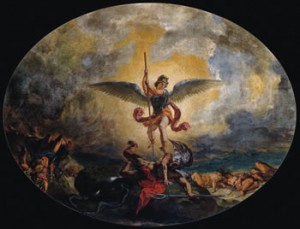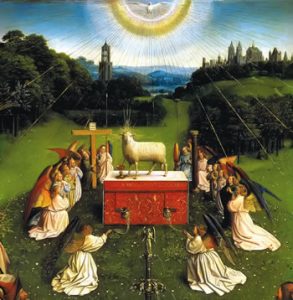The Book of Revelation (5) Chapters 12 to 14
John now takes an ancient Greek myth in which the dragon Python attempts to kill the newborn son of the god Zeus. The mother Leto fled to the island of Delos. There the son of Zeus, the god Apollo, was born. Apollo very soon kills the dragon. The Romans re-worked the myth into an impressive bit of imperial propaganda. Several of the emperors claimed descent from the god Apollo. Like the god, the emperors’ images on coins show beams of sunlight radiating from the rulers’ heads. The mother became the goddess Roma. Rome and its emperors took credit for establishing peace and destroying the chaos monster.
John reworks the myth yet again. Weaving in biblical imagery, John retells the story. The woman is the ancient people of God, Israel, who gave birth to the Messiah. (In art, the woman is often the Virgin Mary. This is not John’s immediate reference, but Mary is the one through whom Israel brought forth the Messiah.) John writes that “the child is to rule all the nations with a rod of iron,” a reference to Psalm 2, taken by the Jews as predictive of the Messiah. John telescopes the entire earthly career of Jesus into just two events – birth and ascension – since he knows his audience is familiar with the events of Jesus’ life. John explicitly identifies the dragon as Satan.
War breaks out in heaven. The archangel Michael leads the forces of heaven in casting out Satan and his minions down to earth. Remember that this is apocalyptic imagery. In reality there is only one victory, the victory of Christ on the cross. Michael is the heavenly protector of the Old Testament people of God, and by extension of the New Testament people of God, the Church. The name Michael in Hebrew means, “Who is like God?” In chapter 13, we’ll meet two beasts. People ask, “Who is like the beast?” This is a poor substitute for the awesome majesty of God, like whom there is no other.
Having failed to kill the Messiah, Satan makes war on the woman and her other children, the faithful members of the churches. Reminiscent of Exodus 19:4 (“I bore you on eagles’ wings and brought you to myself”), the woman is given wings to escape into the wilderness. The dragon spews a great river after the woman, but the earth itself enters as a character and consumes the flood Satan had unleashed.
Two beasts are called forth by the dragon, one from the sea and one from the land. Together with the dragon, these beasts are sometimes called the unholy trinity. The beast from the sea is the Roman Empire, which received power from Satan. The beast is described as a combination of the beasts of Daniel 7. (Rome is worse than all the Old Testament kingdoms that oppressed Israel.) The beast comes from the sea for two reasons: 1) in the Old Testament, the sea is a symbol of chaos and evil; 2) in fact, Rome came to Asia Minor by sea. The fact that the beast seems to have recovered from a mortal wound reminds the audience of Nero (who committed suicide by stabbing himself in the neck), the first emperor to persecute Christians. Emperors who claim divine status continue to act like Nero. The thought that Nero is alive once more is a parody of the Lamb who was slain but is risen.
John introduces a second beast, one from the land. In other words this beast is indigenous and is to be equated with the local leaders of the province of Asia, who foster Roman ways, including emperor worship. John says the second beast “has two horns like a lamb,” but “it spoke like a dragon.” The land beast also pretends to be Jesus the Lamb, but its voice betrays it as a minion of Satan.
In chapter 7, the followers of the Lamb are sealed by God. Now in chapter 13 the followers of the beast are marked. Once again evil parodies good. Neither God’s seal nor the beast’s mark is visible. It is a matter of allegiance. To whom will John’s audience belong? To God and the Lamb? Or to the beast? There can be no middle ground. That no one can buy or sell without the mark of the beast probably refers to the necessity of using coins with images and “divine” titles of emperors. Being faithful to Jesus caused economic problems for devout Christians.
We come now to the number of the (first) beast, 666 (or in some ancient manuscripts 616). Ancient languages used letters for numbers. (Remember learning Roman numerals?) Greek and Hebrew also used letters in this way. The most likely candidate (and remember, any candidate must be someone from John’s time, not ours) is again the hated Nero. His Greek name transliterated into Hebrew characters adds up to 666. (In manuscripts where his name is spelled without the second “n,” thereby decreasing the numerical value by fifty, the number of the beast is 616.) Apart from determining an individual for this role, we should note that 7 is the number of perfection and 6 is the number of imperfection. The number 666 is therefore the number of the greatest imperfection (a negative variation of “holy, holy, holy,” meaning “most holy”).
Chapter 14 begins with a heavenly scene of the victorious Lamb and his 144,000 (again a symbolic number) followers. There is a puzzling and somewhat disturbing description, “It is these who have not defiled themselves with women, for they are virgins.” This sounds both anti-sexuality and misogynistic. Today we would not consider sexual contact with a woman “defiling.” Scripture scholar Mark Braaten (Come, Lord Jesus) explains: “In the Old Testament, soldiers were expected to refrain from sex before battles. These people are God’s army who have fought a holy war, and therefore identified as having refrained from sex.” Virginity here is symbolic, as when John, like the prophets of old, describes idolatry as fornication. And, of course, the 144,000 followers include both females and males.
Verses 14-16 speak of a grain harvest, a biblical symbol for bringing in the kingdom of God. Verses 17-20 speak of a reaping, a time of wrath for those who are not faithful to Jesus.
February: Revelation 15:1-19:10



 Entries(RSS)
Entries(RSS)